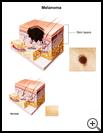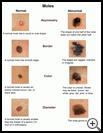
Melanoma
________________________________________________________________________
KEY POINTS
- Melanoma is an uncontrolled, abnormal growth of cells that is a type of skin cancer.
- Treatment may include surgery, chemotherapy, radiation, or medicine to help your immune system fight cancer or block the growth of cancer cells. Often, more than 1 treatment is used.
- After treatment, you will need to have regular follow-up visits with your healthcare provider.
________________________________________________________________________
What is melanoma?
Melanoma is an uncontrolled, abnormal growth of cells that starts in skin cells called melanocytes. It is a type of skin cancer. Melanocytes make melanin, the pigment that colors the skin, hair, and iris of the eye.
Melanoma is the most deadly form of skin cancer. The sooner cancer is found and treated, the better your chances for recovery. However, even advanced cancer can usually be treated. Treatment may slow or stop the growth of the cancer and ease symptoms for a time. Ask your healthcare provider what you can expect with your treatment plan.
What is the cause?
Exposure to UV rays from sunlight or tanning beds, especially early in life, is usually the cause of melanoma. You may have a higher risk for melanoma if:
- You have fair skin, naturally red or blonde hair, and light-colored eyes.
- You have a history of sunburns, especially one or more severe sunburns before you were 18.
- You have many (more than 50) moles.
- You have had melanoma or another type of skin cancer.
- You have a family history of melanoma.
- You have a type of mole called dysplastic nevi. These moles are larger than ordinary moles and have irregular borders. The moles may range from pink to dark brown. Many people have a few of these abnormal moles. Your risk of melanoma is higher if you have a lot of them.
- You have a weakened immune system because of another cancer, drugs used for an organ transplant, or HIV (human immunodeficiency virus) infection.
What are the symptoms?
Melanoma usually develops on areas of skin exposed to the sun, but it may occur anywhere on the body. In men, melanoma tends to develop on the trunk between the shoulders and hips, the head, or the neck. Women tend to get melanoma more on the lower legs. Melanoma in black people and other people with dark skin is rare. When it occurs, it usually is under the fingernails or toenails, or on the palms and soles of the feet.
The most common symptom in the early stages of melanoma is a change in the size, shape, color, or feel of an existing mole. Many melanomas have a black or blue-black area. It may also show up as a new mole.
Think of the letters A, B, C, and D to remember the guidelines for checking for abnormal moles:
- Asymmetry: The shape of one half of the mole does not match the other half.
- Border: The edges are ragged, notched, or irregular.
- Color: The color is uneven. Moles may be black, brown, tan, white, grey, red, pink, or blue.
- Diameter: There is a change in size. Melanomas are usually bigger than the eraser of a pencil (1/4 inch or 5 millimeters).
Melanomas vary greatly in how they look. It is important to check your skin regularly and to have skin exams by your healthcare provider at routine checkups.
What is metastasis?
The spread of cancer cells from one part of the body to other parts is called metastasis. What causes cancer to spread is not known. Cancer cells can:
- Grow into the area around the tumor
- Travel to other parts of the body through the bloodstream or the lymph system. The lymph system is part of your body's system for fighting infection. The lymph system consists of lymph nodes that store blood cells (lymphocytes) to fight infection and vessels that carry fluid, nutrients, and wastes between your body and your bloodstream.
New tumors then grow in these other areas. When melanoma spreads, it is most often found in the lymph nodes, other skin areas, and lungs.
Sometimes your first symptoms of cancer are in the part of the body where the cancer has spread. The symptoms of melanoma that has spread to another part of your body depend on where the tumors are. For example:
- If the cancer has spread to the lymph nodes, you may have heaviness, aching, and swelling in your arms, legs, or belly.
- If the cancer has spread to the lungs, you may have a cough or trouble breathing.
How is it diagnosed?
Your healthcare provider will ask about your symptoms and medical history and examine you. You may have a biopsy if you have a suspicious mole. A biopsy is a procedure that removes all or part of the skin growth for lab tests.
If melanoma is found, you may have other tests:
- Chest X-ray to examine the lungs
- Blood tests
- CT scan, which uses X-rays and a computer to show detailed pictures of the liver, bones, and brain
How is it treated?
Some things to think about when making treatment decisions are:
- Your age
- Your overall health
- The stage of the cancer (how advanced the cancer is)
- Whether the cancer has spread to other parts of your body
Surgery is the usual treatment. The entire melanoma, including a wide border of healthy tissue around it, is removed. In some cases, you may have a skin graft, which uses skin from another part of your body to replace the skin that was removed.
If the melanoma has spread to other parts of your body, treatment may include:
- Biological therapy, which uses medicine designed to help your immune system fight the cancer or block the growth of cancer cells
- Chemotherapy (anticancer drugs), which uses medicine to kill cancer cells
- Radiation therapy, which uses high-energy X-rays to kill cancer cells
- Surgery, which removes cancer cells
Your treatment will also include:
- Preventing infections
- Controlling pain or other symptoms you may be having
- Controlling the side effects from treatments
- Helping you manage your life with cancer
Often, more than 1 treatment is used. You will need to have regular follow-up visits with your healthcare provider.
Ask your healthcare provider about clinical trials that might be available to you. Clinical trials are research studies to find effective cancer treatments. It’s always your choice whether you take part in one or not.
How can I take care of myself?
If you have been diagnosed with melanoma:
- Talk about your cancer and treatment options with your healthcare provider. Make sure you understand your choices.
- Follow the full course of treatment prescribed by your healthcare provider.
- Ask your healthcare provider:
- How and when you will get your test results
- How long it will take to recover
- If there are activities you should avoid and when you can return to your normal activities
- How to take care of yourself at home
- What symptoms or problems you should watch for and what to do if you have them
Make sure you know when you should come back for a checkup. Keep all appointments for provider visits or tests.
Other things that may help include:
- Avoid exposing your skin to too much sun. When you are outdoors:
- Wear clothing and hats that cover you, and stay out of the midday sun as much as possible.
- Use sunscreen. The higher the sun protection factor (SPF) of the sunscreen, the more your skin is protected. Use a product with an SPF of at least 15. For water sports, use a sunscreen lotion that does not wash off in the water. If you are allergic to PABA, use PABA-free sunscreen lotion. And remember that UV rays from the sun can cause sunburn or damage even on cloudy days.
- Check your skin regularly and report any changes to your healthcare provider right away. If you are at high risk, see your provider for exams as recommended.
- Don’t use sunlamps or tanning beds.
- Eat a healthy diet and get regular exercise as recommended by your healthcare provider.
- Get plenty of rest.
- Try to reduce stress and take time for activities that you enjoy. It may help to talk with a counselor about your illness.
- Talk with your family and your healthcare providers about your concerns. Ask your healthcare provider any questions you have about the disease, treatments, side effects of the treatments, sexual activity, support groups, and anything else that concerns you.
- If you smoke, try to quit.
- Ask your provider if you need to avoid drinking alcohol. It may interfere with medicines you are taking. Alcohol can also make it harder for white blood cells to fight infections.
For more information on cancer, contact:
- American Cancer Society, Inc.
800-227-2345
http://www.cancer.org - Cancer Information Service
800-422-6237
https://www.cancer.gov/contact/contact-center


